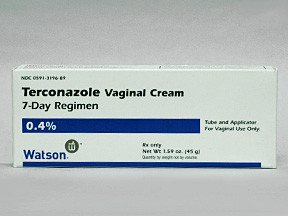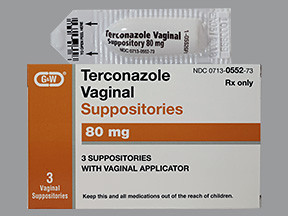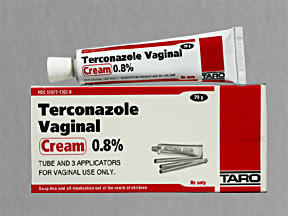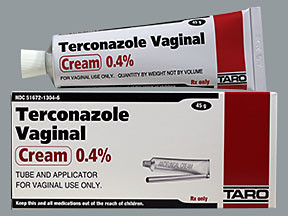TERCONAZOLE CREAM, SUPPOSITORY - VAGINAL
PHONETIC PRONUNCIATION: (ter-KONE-a-zole)
COMMON BRAND NAME(S): Terazol 3, Terazol 7
GENERIC NAME(S): terconazole
Uses
USES: This medication is used to treat vaginal yeast infections. Terconazole reduces vaginal burning, itching, and discharge that may occur with this condition. This medication is an azole antifungal. It works by stopping the growth of yeast (fungus) that causes the infection.
How to use TERCONAZOLE CREAM, SUPPOSITORY - VAGINAL
HOW TO USE: Read the Patient Information Leaflet if available from your pharmacist before you start using terconazole, and each time you get a refill. If you have any questions regarding the information, consult your doctor or pharmacist. This product is for vaginal use only. Wash your hands before and after use. Avoid contact with your eyes. If it gets into your eyes, wash them right away with plenty of water. Call your doctor if eye irritation persists. Use this product usually once daily at bedtime for 3 or 7 days (depending on product) or as directed by your doctor. The dosage and length of treatment is based on your medical condition and response to treatment. Learn all preparation and usage instructions in the product package. If using the cream, use the applicator. If using the suppository, you may use either the applicator or your finger to insert it. Unwrap the suppository before use. Follow the package instructions on how to fill the applicator with the cream or with a suppository. Lie on your back with your knees toward your chest. Insert the applicator or suppository into the vagina as far as it will comfortably go. Slowly press the plunger of the applicator in to release the medication. Clean the applicator with warm soapy water, rinse well, and dry. If you have itching/burning around the outside of the vagina (vulva), you may also apply terconazole cream once daily to that area and rub in. Continue to use this medication every day until the full prescribed amount is finished, even if symptoms disappear after 1 to 2 days. Stopping the medication too soon may allow the yeast to continue to grow, which may result in a return of the infection. You may use this product during your menstrual period. Do not use tampons or douches while using this medication. Unscented sanitary napkins may be used for your menstrual period or to protect your clothing from leakage of the medication. Tell your doctor if your condition does not improve or if it returns within 2 months. You may need a different or additional medication to treat your condition.
Side Effects
Precautions
Interactions
Overdose
Images
Reviews
Faq for TERCONAZOLE CREAM, SUPPOSITORY - VAGINAL
Terconazole cream/suppository is used to treat vaginal yeast infections caused by the fungus Candida.
Terconazole works by stopping the growth of the fungus and killing it, thereby treating the infection.
For treatment, terconazole cream/suppository should be inserted into the vagina using the applicator provided. It is usually used once a day, either before bedtime or as directed by your doctor. Be sure to follow the instructions on the packaging or as prescribed by your healthcare provider.
Terconazole typically starts working within a few days, with symptoms improving within 3 days and the infection completely clearing up within 7 days. However, it is important to complete the full course of treatment as prescribed by your doctor, even if symptoms improve before the end of the treatment duration.
Like any medication, terconazole can cause side effects. The most common side effects include vaginal burning, irritation, itching, or discharge. If you experience severe or persistent side effects, contact your doctor.
It is important to consult with your doctor or healthcare provider before using terconazole during pregnancy or while breastfeeding. They can evaluate the potential risks and benefits and determine if it is safe for you to use.
There are no known significant drug interactions with terconazole. However, it is always important to inform your doctor or pharmacist about all the medications, supplements, or herbal products you are currently taking.
If you miss a dose, apply it as soon as you remember. However, if it is close to the time for your next scheduled dose, skip the missed dose and continue with your regular dosing schedule. Do not double up on doses to make up for a missed one.
Terconazole does not prevent future yeast infections. It is used specifically for the treatment of a current infection. If you frequently experience yeast infections, speak to your doctor to identify potential underlying causes and discuss preventive measures.
Disclaimer
IMPORTANT: HOW TO USE THIS INFORMATION: This is a summary and does NOT have all possible information about this product. This information does not assure that this product is safe, effective, or appropriate for you. This information is not individual medical advice and does not substitute for the advice of your health care professional. Always ask your health care professional for complete information about this product and your specific health needs.





No Reviews Yet